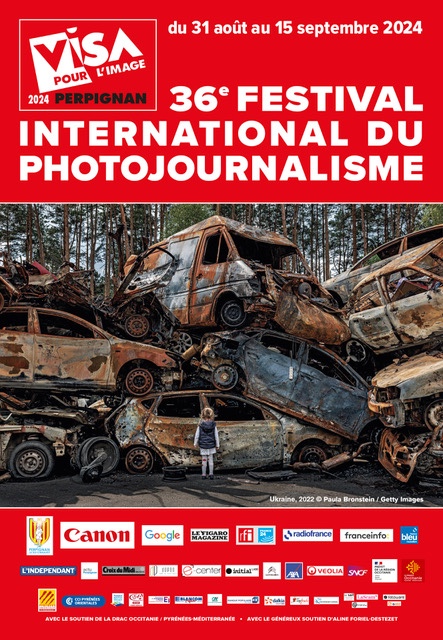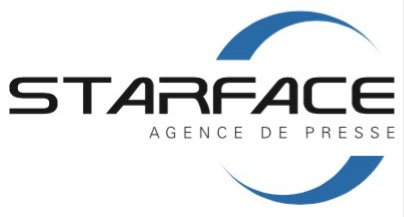Jean-François Leroy of Visa by Michel Puech in La lettre de la photographie
Yesterday in Perpignan, as every year at dawn, Jean-François Leroy opened the first bottle of champagne to celebrate the beginning of the 23rd International festival of photojournalism “Visa pour l’image – Perpignan”.
For 23 years, during the first week of September, photojournalists, editors, editors in chief, managers of companies gather in the capital of the French Catalogne to make an assessment of the past year, see over thirty exhibitions, watch the giant screen in Campo Santo and party, even If the heart cannot follow as before.
Every year, this extremely dangerous profession celebrates the imperative need to witness wars, conflicts, catastrophes and misery around the world. There are wounded, like Joao Silva who lost his legs in Afghanistan. He meant to come to Perpignan this year, but the doctors have decided to operate again. He will not be here.
And then another one we will not see again: Chris Hondros, Tim Hetherington, Anton Hammerl and the very young Lucas Dolega, lost on “the field of honor”, as we say for veterans. The photojournalists are also veterans, butfor peace, our peace.
Violence is always present in « Visa pour l’image ». Some are offended by the journalists, as if they were the warmongers. Stupid.
The world is cruel not only in the battlefields but also in the famous “market”: The number of bankruptcies of press agencies is enormous, and the situation of the photo journalists is becoming more and more precarious.
When we ask the director of the festival what has changed during these 23 years, he answers without hesitation:
“The disappearance of agencies and photo editors. I shall not make the list, but it makes me sad, and then I will forget some.”
Consequences?
“Increasingly today, photographers are working most of the time by themselves, without an editor, in order to prepare the subjects, no editor to help them to select their images. I receive CDs with hundreds of photographs with no caption, no precision whatsoever. That is no longer photojournalism.
“The difference can be seen…. Look at the work of photographers of National Geographic, for instance. They really have staff to take care of the photographers! Their work is more finished. When I see what I receive for Visa, thousands of millions of pictures, I have the impression that editors, editors in chief are terribly missing to photographers!”
“But that is true for all of journalism… When we would give them 15 days to make 10 pages, we give them 2 to write 20! There is then, in photography, as in text, less and less research in depth. What used to be general became an exception.”
“I refer to most magazines… As there still are, luckily, people that take their time to go deep into things. Butglobally, there is less and less space for quality photography. We assist, and this is the first year that I say it, to a leveling by the lowest. More and more people are accepting mediocrity.”
Why?
Technique has become so easy that anyone is capable to take a decent picture! But to create a subject, tell a story, is a whole different thing….. There are more and more decent offers, but less exceptional reportages.”
And Photoshop?
Despite my repeated rants, I must admit that I would love to make a Visa without Photoshop, there would only be four exhibitions instead of twenty eight! Basically everybody uses this tool in a good or bad way. It would take a conscience from the entire chain of photographers, agencies and newspapers that publish the photographs!”
“For exemple: Libya. I receive the same scene taken by fifty photographers. A shot of the desert, everyone knows the light is horrible… But then I find myself with photographs with a light that resembles a fall in Amsterdam… That’s shocking! I do not want to attack photo editors, nor photo services… We reduce every year the budgets, as they do not have time to verify all, but it’s dramatic. That is why in the big magazines like Geo or National Geographic there are people whose job is to verify that the documents have not been retouched.”
Are there a lot of people enrolled for this Visa 2011?
In pre-accreditation we are in the same amounts as last year. There will be 1500 accreditations approximately, plus all those who come but do not have accreditations in order not to pay… In terms of agency stands in the Palais des Congres.. our offer of less expensive stands has not had the success everyone predicted. Reasonable considering the number of agencies that closed.”
What Jean-François Leroy is not saying is that some agencies (and not just a few), press editors (and not a few) do not rent a space to the company “Image Evidence” that organizes the festival, but become parasites on the back of the animal. They organize cocktails, projection, conferences without collaborating with “Visa pour l’Image”. A dangerous activity that could in the short term jeopardize the existence of this festival.
Quite a paradox, as the newspaper’s managers think that photojournalism does not sell anymore, last year they sold 225,000 tickets to exhibitions, and probably the same amount will be sold this year. And also, curiously, the Ministry of Culture and Communications still frugally calculates their subvention.
A “bad spirit” as mine, cannot help to ask himself: will press editors, agencies, and the Ministry be witness to the economic fall of the present organization and become more generous with the successor of a Jean-François Leroy, whose frank word and rants are not appreciated by everyone? That would be the worst forecast that could be made by those who intend to “save photojournalism”, on the condition that it will only cost a signature in a petition.
Michel PuechDernière révision le 31 août 2011 à 9;53 par Michel Puech
- Maurice Achard
« Même quand il fait beau… » - 12 juillet 2024 - « Mimi » Marchand
Bestimage for ever ? - 14 juin 2024 - Villa Tamaris
Yvette, « l’intrépide aviatrice » photographiée par Robert Doisneau - 31 mai 2024




